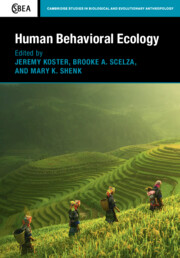Book contents
- Human Behavioral Ecology
- Cambridge Studies in Biological and Evolutionary Anthropology
- Human Behavioral Ecology
- Copyright page
- Contents
- Contributors
- Foreword: Reflections on Five Decades of Human Behavioral Ecology
- 1 Human Behavioral Ecology
- 2 Life History
- 3 Foraging Strategies
- 4 Modes of Production
- 5 Cooperation
- 6 Division of Labor
- 7 Status
- 8 Political Organization
- 9 Mating
- 10 Marriage
- 11 Parental Care
- 12 Allocare
- 13 Demography
- 14 Human Biology
- 15 Cultural Evolution
- 16 Evolutionary Psychology
- 17 The End of Human Behavioral Ecology
- Bibliography
- Index
10 - Marriage
Published online by Cambridge University Press: 07 March 2024
- Human Behavioral Ecology
- Cambridge Studies in Biological and Evolutionary Anthropology
- Human Behavioral Ecology
- Copyright page
- Contents
- Contributors
- Foreword: Reflections on Five Decades of Human Behavioral Ecology
- 1 Human Behavioral Ecology
- 2 Life History
- 3 Foraging Strategies
- 4 Modes of Production
- 5 Cooperation
- 6 Division of Labor
- 7 Status
- 8 Political Organization
- 9 Mating
- 10 Marriage
- 11 Parental Care
- 12 Allocare
- 13 Demography
- 14 Human Biology
- 15 Cultural Evolution
- 16 Evolutionary Psychology
- 17 The End of Human Behavioral Ecology
- Bibliography
- Index
Summary
Marriage is an evolutionary puzzle: It is unique to our species and found across human societies, yet also varies widely in form and function. Human marriage likely evolved from ancestral primate patterns of pair bonding and its universality in human societies suggests a deep evolutionary history. Indeed, some have argued that marriage is part of the evolution of a human-specific social structure linking relatives and nonrelatives together into uniquely large and complex social groups. Yet, the many cross-culturally variable aspects of marriage show how marriage systems are shaped by adaptive responses to local subsistence systems and environments through strategic decision-making relevant to reproduction, parental investment, and the acquisition and distribution of resources. Marriage is thus a species-typical adaptation with locally adaptive variation that has coevolved with systems of kinship, family, and inheritance – providing a profound example of the entanglement of human biological and cultural evolution. This chapter explores the evolutionary underpinnings of marriage and how patterns of marriage vary cross-culturally in response to local ecological conditions, focusing on the functions of marriage, when to marry, whom to marry, who makes marriage decisions, how many spouses one should have, where one should live after marriage, and how marriage is bound up in systems of resources, kinship, parental investment, and exchange.
Keywords
- Type
- Chapter
- Information
- Human Behavioral Ecology , pp. 230 - 255Publisher: Cambridge University PressPrint publication year: 2024
- 1
- Cited by

